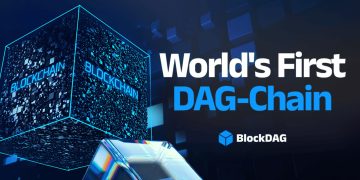A decentralized application (DApp) is a distributed, open-source application that runs on a blockchain network with smart contracting capabilities.
What Is Decentralized Applications (DApps)
DApp meaning: DApp is a combination of two words, decentralized and application. DApps have capabilities similar to other software applications which run on a website or mobile device. The difference is that DApps exist on a blockchain network.
Since they can be open source and built on a public blockchain, others can build on top of them once they are deployed. No central entity controls a DApp, meaning the imagination of its creators only limits the possibilities. Currently, most DApps deployed are decentralized finance (DeFi) and NFTs. However, various other applications are possible, including gaming, social media, and web browsing.
Most DApps today are built on top of the Ethereum blockchain. However, there are others in the BNB Chain, Solana, Waves, Tron, EOS, and all other smart contracting platforms. These dApps have distinct advantages over typical applications and are always online, possessing high reliability levels.
How DApps Work
Decentralized applications have a few common attributes, no matter the use case. The first one is that all DApps are open source. That means that they are community-driven, and the community makes decisions on changes to the software. In short, the community is open and accessible for all members to analyze and evaluate.
Second, all DApps provide decentralized storage. All data generated and fed into a DApp is stored on decentralized blocks. This data is accessible to the public for scrutiny. The third trait that is common amongst all DApps is that they offer cryptographically secured data blocks, which are validated by the community.
DApps can store data and execute commands on the blockchain. DApps rely on cryptographic tokens to validate instructions, which grant access to the application. They work like conventional apps, using the same front-end code needed to render web pages. However, the back-end is where things differ. A DApp does not run on a centralized server. Instead, it runs on a decentralized blockchain network.
With traditional apps, the database and servers are controlled by one entity. The entity behind these centralized apps can shut down operations anytime they want. With a DApp, the smart contract runs on the blockchain. That means once deployed, there is no way of shutting down a DApp.
DApps are supported by smart contracts, which enforce the rules predefined in the code during transactions. Since the smart contract is made of only back-end code, it often makes up just a tiny part of the entire DApp. To create a DApp on a smart contract system, several smart contracts and a third-party component to handle the front-end code are needed.
Due to the specialized nature of some DApps, they cannot work on a regular web browser. Instead, they can only run on websites and apps whose code has been modified to open a specific application.
Advantages of DApps
The biggest benefit of DApps is that a central entity does not control them. That benefits those on the fringes of the mainstream financial world. DApps offer the opportunity for anyone to be part of the global financial system without going through any centralized third parties.
Privacy
The main advantage of DApps is that they provide complete privacy to the users. Data theft through apps is very common these days but DApps don’t ask to submit personal features hence it is completely safe to use DApps.
Zero Downtime
DApps have been found to have more flexibility as compared to centralized apps because they don’t need to be connected to a single server. It means there is less interruption and zero downtime.
Data Integrity
Data or information once stored on a blockchain remains there forever. It ensures data integrity as these apps are more resistant to modification.
Autonomy
DApps are developed through autonomy which means any changes or transactions must be through consensus. Apps are not dependent on any authority for these changes.
Disadvantages of DApps
User-Friendliness
As the DApps are still in the early development stage, they are not user-friendly. People expect to get intuitive apps as the trend has already been set by centralized apps.
Coding
Making changes in the coding of DApps is difficult. Every app requires some changes either to improve it or fix some bugs but it is a big disadvantage of DApps that making changes is time-taking and difficult.
Maintenance
Maintenance of DApps is hard because the codes and data once published on a blockchain are difficult to amend.
Scalability
DApps have inherited the scalability problem from the blockchain. There is a still long way to get on-chain and off-chain scalability in DApps.
Examples of DApps
Bitcoin
The first-ever DApp is Bitcoin. It allowed downloading a piece of code (open-source) and joining a blockchain network. Still, after a dozen years, Bitcoin’s dominance is unchallenged. This example is helpful to understand DApp crypto meaning.
Brave
Brave DApp is a rapidly growing web browser that has come directly in the way of Chrome’s popularity. It values consumers and has more than 9 million active users. It can be considered the most common DApp utility software.
Golem
Golem is also a DApp that is designed to make a global market of unused computing power for better utilization. Its aim is to combine the power of PCs to create a rentable supercomputer that will be available for everyone.
Prism
Prism is based on Ethereum and the initiative of ShapeShift, a community-owned open-source trading platform. Prism is an asset portfolio market that allows traders to invest in crypto and define their own proportion.
KYC-Chain
Various businesses have been using this app to confirm the identities of their clients. It works in real-time scenarios and has data from all over the world and in future it can become the most widely used DApp.






















